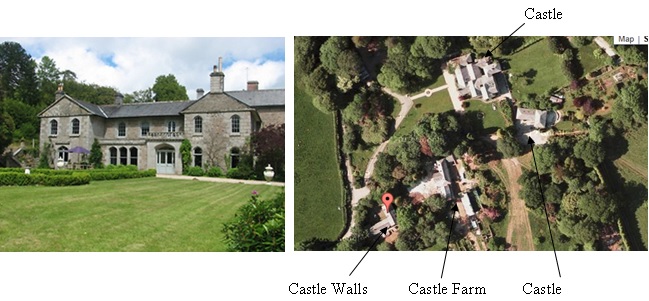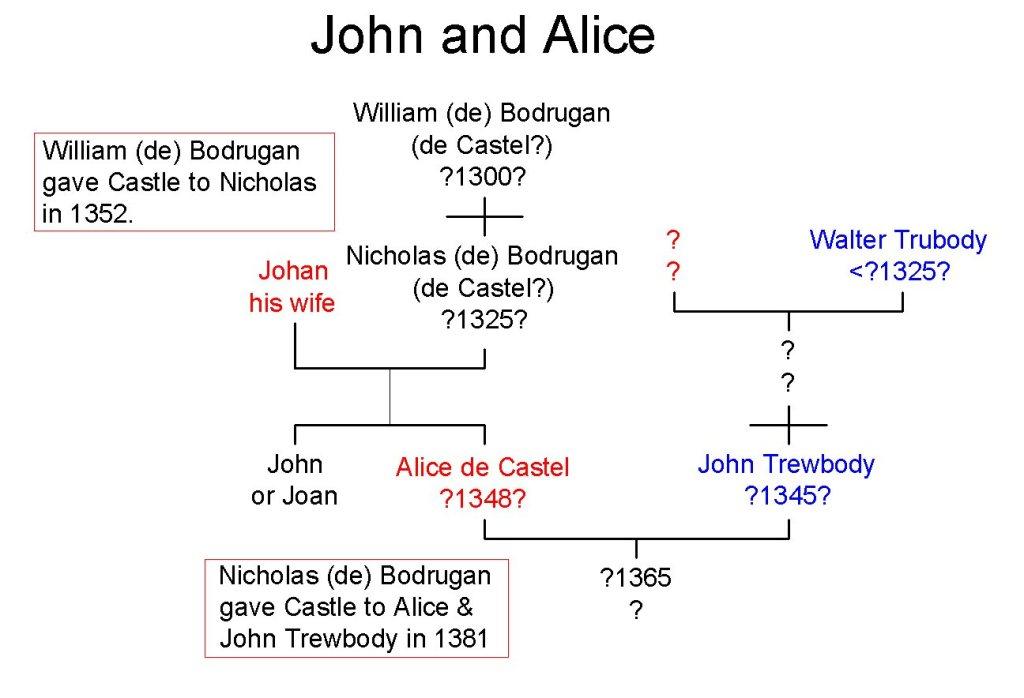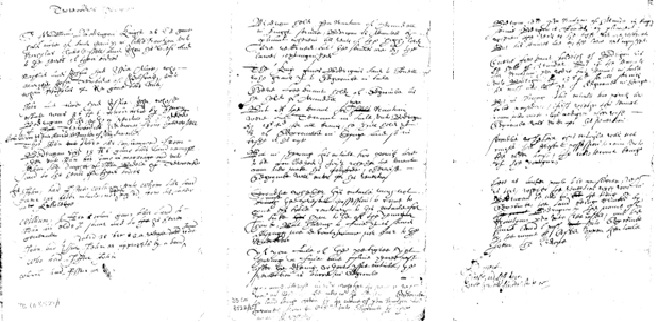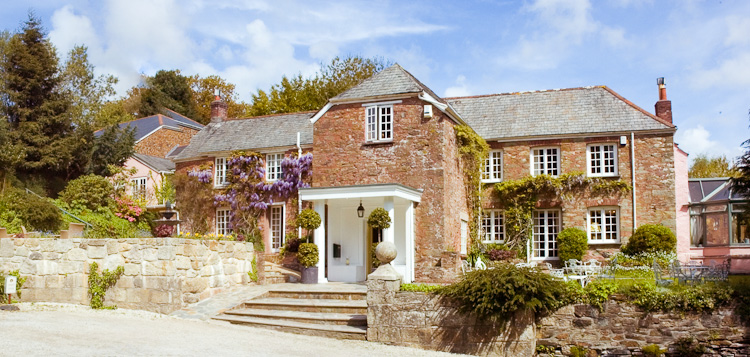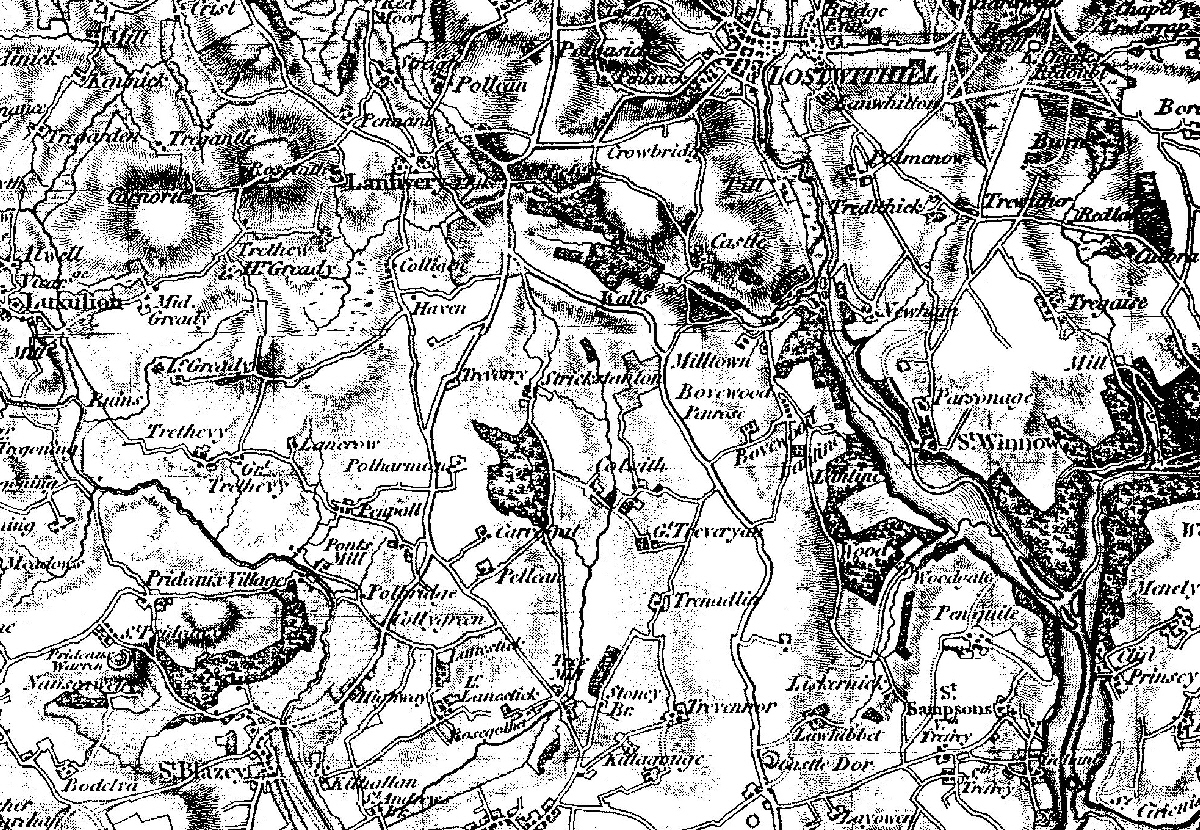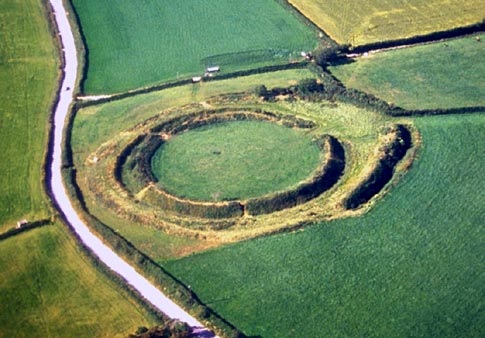| Home | How To Use | The Name | Search | Additional | Trees | Contact Me | Updates |
|
|
The present house at Castle, built about 1810, replaced the medieval manor house.
The medieval house was possibly built by Nicholas (or William?) de Castel/Bodrugan in the 1300’s. This house was most likely made of stone
because there has always been a good supply of it in Cornwall whereas there has never much tree cover there. At least not trees large enough
to use for making long and strong supporting beams for a manor house. The first record that I can find of Castle
and Trewbody is this one from the Cornish Records Office (doc ref. no. CN/788)
dated 12th May 1381 but Castle was then called Nantyan :- Grant. Nicholas atte Castel to John Trewbody of Nithera Polscoath, and his wife Alice, daughter of Nicholas atte Castel, a Messuage and half a Cornish acre in Nantyan.
1. John was the son of Walter Trewbody of Nithera Polscoth – see item 4 below.
Who were the Bodrugan's? 3. That Alice was noted as heir to the estate is unusual. In the age of primogeniture even if she was the eldest child a yoiunger
brother would have had precedence. Was she then the only surviving child of Nicholas? If Alice and John Trewbody were married around 1365 that
would put her birth around 1348 because in those days girls of ‘good’ lineage were usually wed by the age of 17. The Great Plague was rampant
in 1348/49 so if Alice did have an older brother, who would more likely to have been Nicholas’s heir, it may be that he, and any other more
eligible brothers, had died. The plague killed of 40% of the population so this scenario is not all that fanciful. However, the full details
of the transfer to Alice and John - CRO Ref AP/S/3924 - shown below does indicate that Alice did have other brothers, Walter and John, who
were possibly younger than her i.e. born after 1348.
And finally there is this document which confirms that on the 12 May 1381, Nicholas atte Castel (son of Nicholas) granted the land called
Little Nantyan, to his daughter Alice and her husband, John TREWBODY of Nitherapolscoth, and to their lawful heirs.
Source: CRO Ref AP/S/3924 ‘Know present and future that I, Nicholas atte Castel, have given and granted, and by this my present charter have confirmed, to
John TREWBODY of Nithera Polscoth and Alice his wife, the daughter of me, a messuage, and a Half Cornish Acre of land in Little Nantyan,
being marshy ground neighbouring that was previously held by my father Nicholas, all the aforesaid messuage and land with their appurtenances to be
had forever to the aforesaid John, Alice, and to the heirs between them lawfully begotten or to be begotten, freely and quietly, by right of
inheritance, holding of the principal lord by due service and custom. There would then seem to be no doubt that from 12th May 1381 the place called Nantyan, which later became known as Castle, was owned
through marriage, by the Trewbody/Trubody family. I can only think that it is coincidental that the Peasants Revolt began in June 1381.
See Stephen Truebody - A
Codicote Hero on the Additional page. Another document called Trewbody Pedigree from circa 1630 (Cornwall Record Office: CN 3522/1 & 3522/2) spells out the terms and conditions
of the gift and also provides some details of John and Alice's descendants :-
Transcribed by Jill Martin (Hawkesbury Local History Society), Bristol, 19th January 2013. Sir William Bodrugan Knight 26 E 3 (=
26th year of reign of Edward III or 1352) gave half acre of land Cornish in little Nantyan unto Nicholas
atte Castell and Johan (Joan) his wife and to the heirs of their bodies. The document continues without mentioning the Trewbody name again. Trewbody ownership of Castle therefore goes from :- Ownership then passed to Samuel’s daughter Catherine (1721) who married Philip Carlyon in 1741.
Who were the Carlyon's? The CRO hold some 3456 files relating to the Carlyon’s dating from the 13th century until 1951.
The documents include title deeds for Tregrehan, held by the Carlyons since 1565. Apart from a few early
Bodrugan deeds, they show purchases of parts of Tregrehan by successive Carlyons in the sixteenth and early seventeenth centuries,
although the Edgcumbes of Mount Edgcumbe were still the overlords of the manor.
It is clear then that the Carlyons were another important family in the area and the Trrewbody’s had a long
relationship with them. Tree Cornwall 1 begins with John Trubody married to a Mary Corrylon.
Corrylon has all the elements of Carlyon and I would guess that they are one and the same family name.
(It is strange that the Visitations of Cornwall do not include a Carlyon tree.
Catherine and Philip's son, Edward Trewbody Carlyon, inherited Castle. He died unmarried and childless in 1768 leaving all this property to
his cousin Thomas Carlyon (II), the son of Thomas Carlyon (I) who was the rector of St. Just and who died in 1793.
Edward Carlyon, son of Thomas and Mary, in 1820 married Anna Maria Spry of Place. The ownership of the property seems to have been in contention between the Trewbody’s, a Henry Bodrugan and the Edgcumbe family from the late 1590’s. Document ref. no. CN/1508 But A2A document CN/117b - 1680 - seems to imply that Trewbody’s did own the lands at Castle. They also owned lands at Boscundle. Document ref. no. CN/117b Document CN/1531 Document ref. no. CN/1509 Document ref. no. CN/1510/1,2 But this document is surely the clincher :- Document ref. no. CN/791 Game, set and match!
Top Census Records. The 1841 census indicates a Phillippa Williams as occupier (or was she the owner?). By 1849 Castle was owned by Richard Foster and then by his widow
Caroline The 1851, 1861 and 1871 censuses confirm this. The house is called Castle or Castle House, Lanlivery. Richard Foster was a banker. The 1881 census shows Colman Battie Rashleigh as owner or occupier. He is listed as a Captain Militia Artillery D.L.A.J.P. The 1891 census shows William Pease as the owner and the house now called Castle, Shire Hall Moor, Lanlivery, Sweetshouse, Lostwithiel. William Pease was a solicitor.The 1901 census shows William Pease as a widower and he was at Victoria Terrace, Newquay but he could have been visiting his daughters who were also there. The census lists an Elizabeth Berry living at Shire Hall Moor House, Lostwithiel which may or may not be Castle. She is listed as ‘Living on own means’. (The 1911 census shows a Betty Berry living as a servant for a Crowhurst family at Penventon, Bodmin. Possibly a different person.).The List of Electors for 1902 shows William Pease as living at Castle which probably indicates that the List of Electors was out of date. - http://www.cornwall-opc.org/Par_new/l_m/pdfs/lanlivery_electors_1902.pdf. The 1911 census shows Count Eberhard Von Fabrice as occupier. He is listed as ‘Equerry In Waiting To H M The King Of Saxony’, Retired Calvary Captain. Born in 1852, he was German resident for apart of the year.Kelly’s Directory for 1914 (http://www.cornwall-opc.org/Records/parishes/L-P/lanlivery_directory_1914.php) shows that ‘Castle, the property of Richard Foster esq.(which is strange as he died before 1871 census and his widow died in 1875!), Justice of the Peace of Lanwithan, is a mansion of stone and granite, beautifully situated in a well-wooded park, 1 mile south of Lostwithiel, and is at present occupied by Count Eluhart von Fabrice.’
Top Boscundle, nr St. Austell. According to http://www.houseofnames.com/trewbody-family-crest the name Trewbody is ‘first found in Cornwall where they held a family seat as Lords of Boscundle'. The area of land known as Boscundle (including the mines?) was owned by the Trewbody’s from 1603 until Katherine Trewbody’s marriage to Philip Carlyon in 1741. Katherine Trewbody, (heiress to the family of Trewbody whose seat was originally at Castle in Lanlivery married Philip Carlyon in 1741 (CN/99) which, once her parents died, added further properties to the Carlyon estates, including Boscundle, which the Trewbodys purchased gradually between 1603 and 1759 (CN/16-21) and which had more recently been their home. Katherine and Philip's son, Edward Trewbody Carlyon, inherited Boscundle (and Castle). He died unmarried and childless in 1768, leaving all this property to his cousin, Thomas Carlyon, the son of the rector of St. Just.
Built in 1767, Boscundle Manor became home to the mine captain of Wheal Eliza Consoles Mixed Mine, at Boscundle, the 13th largest tin mine in Cornwall and reputedly one of the most prosperous. It is now a country hotel. This mine was started under the name Boscundle Mine in 1851 and formed part of Pembroke Mine until 1863. In 1864, it was restarted as Wheal Eliza.
Top
I include a few notes about Castle Dore because there is some talk that it was connected to Castle :- The site of Castle is reputedly that of King Mark's castle (the defensive stronghold, Castledore, is 2 miles away) and of his nephew Tristan's ill-fated love affair with Isolde. King Mark was a king of Cornwall in the early 6th century. Mark sent his nephew Tristan to fetch his young bride, the Princess Iseult, from Ireland. Tristan and Iseult fell in love and, with the help of a magic potion, proceeded to have one of the stormiest love affairs in medieval literature. Mark suspected the affair, sent for Tristan to be hanged and banished Iseult to a leper colony. Tristan escaped the hanging and rescued Mark's bride from her confinement. Mark eventually forgived them, with Iseult returning to Mark and Tristan leaving the country. http://www.earlybritishkingdoms.com/bios/mark.html Castledore is a defended settlement of Iron Age date. The archaeologist Dr. Ralegh Radford, who excavated the site in 1936/37, considered that a number of roughly parallel lines of post holes were the remains of a ‘Dark-Age timber hall’ with an attached kitchen. This he interpreted as the palace of King Mark.
Did King Mark live at Castle? We will never know but it is an interesting story. |
Designed by HawkeSoft
